
Sannin shogi
Encyclopedia
Sannin shōgi or in full kokusai sannin shōgi (国際三人将棋 international three-person chess), is a three-person shogi variant
invented circa 1930 by Tanigasaki Jisuke and recently revived. It is played on a hexagonal grid of border length 7 with 127 cells. Standard shogi
pieces may be used, and the rules for capture, promotion, drops, etc. are mostly similar to standard shogi. (See that article for an explanation of these terms.) While piece movement differs somewhat from standard shogi, especially in the case of the powerful promoted king, the main difference in play is due to the rules for voluntary and mandatory alliance between two of the three players.
board. The three players occupy non-adjacent sides of the board; the three ranks nearest to them are their territories and their opponents' promotion zones. The 'international' arena inside the three territories remains triangular.
The board is presented here with substitutions by standard shogi pieces; for the names actually used, see below.
The central cell is called the Pleasure Garden and is an additional promotion zone, except for the king. It is drawn with a heavy or double border or otherwise made visually distinct.
In the modern game, standard shogi pieces are used. Each player wields 18 pieces, the standard shogi set of 20 less one knight and one pawn. The pieces face away from the players: That is, they point toward the gap between the opposing players' territories.
The three players represent three countries, and are called First, Middle, and Last. If two players start the game as allies, the remaining player is automatically First. Otherwise any random method may be used to determine the order of play. Play then precedes clockwise from First to Middle to Last.
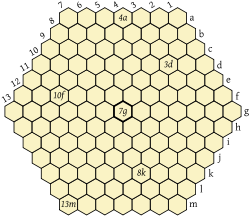 Standard shogi notation is used, with allowance made for the shape of the board. Numbering the ranks poses no problem: They are the rows that are horizontal from the viewpoint of Middle, and are given the letters a through m from top to bottom, with g being the central and widest rank. That is, the territories of First (top right player) and Last (top left player) span ranks a through i, and that of Middle (bottom player) occupies the three ranks k, l, m.
Standard shogi notation is used, with allowance made for the shape of the board. Numbering the ranks poses no problem: They are the rows that are horizontal from the viewpoint of Middle, and are given the letters a through m from top to bottom, with g being the central and widest rank. That is, the territories of First (top right player) and Last (top left player) span ranks a through i, and that of Middle (bottom player) occupies the three ranks k, l, m.
The numbered "columns" are the rows that run from top left to bottom right from the viewpoint of Middle. They are given the numbers 1 to 13 from right to left, with 7 being the central and longest column. That is, First occupies columns 1 to 3, while the territories of Middle and Last span columns 5 through 13.
The Pleasure Garden is thus cell 7g; the corners are at 1a, 1g, 7a, 7m, 13g, 13m; and at setup the three kings occupy 1d, 10m, and 10d; and the three knights 3e, 9k, and 9e.
), the pieces are fair analogues of their standard-shōgi counterparts.
Except when castling, all pieces move in straight lines. These may be step moves, where a piece moves to the nearest cell in a particular direction, or ranging moves, where a piece may continue in a particular direction as long as it does not pass through an occupied cell.
There are two kinds of paths along which pieces move:
These twelve directions correspond to the twelve hours on a clock: The orthogonals correspond to the odd hours (the direction of the hour hand at 1, 3, 5, 7, 9, and 11 o'clock), and the diagonals correspond to the even hours (the hour hand at 12, 2, 4, 6, 8, and 10 o'clock). Only the promoted king has the power to move in all twelve.
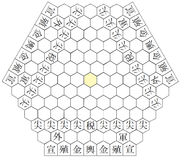

A promoted king (+K; "rising sun") may range along any of the twelve orthogonals or diagonals.
A promoted king also gains the power to "kill by illumination": It may capture, without moving, any pieces that it could capture if it were to move. That is, it may capture more than one piece, but only one piece in any direction and only if they are unprotected by either opposing player. (It is not clear if it must capture all such pieces, or if it may be selective.) It cannot combine this power with a physical move.
A king automatically promotes if the other two players enter into an alliance. A non-allied king (promoted or otherwise) that reaches the central cell of the board (the Pleasure Garden) wins the game.
A promoted rook (+R; "heroism") has a more powerful retreat: It may range along any one of the six orthogonals.
, which has three bishops for this very reason.)
A promoted bishop (+B; "witchcraft") gains the power to step to any adjacent (orthogonal) cell. That is, it may move as a bishop or as a king, and can therefore reach every cell on the board.
The knight (N; "customs") may step to any side cell, orthogonal (3 or 9 o'clock) or diagonal (2, 4, 8, or 10 o'clock).
Neither has the ability to promote.
A promoted silver (+S; "treasure") gains the power to range along the forward and rear diagonals (12 and 6 o'clock).
A promoted lance (+L; "transformation") gains the power to range along the rear orthogonals (5 and 7 o'clock) as well.
A promoted pawn (+p; "dollar") moves like a gold general.
A piece may be captured regardless of any alliance the mover may have with its owner. A castling king may capture as any other moving piece does.
However, unlike in standard shogi
(see article for examples), there being no proper files on a hexagonal board, there is no limit on the number of pawns per file. The restriction against dropping on the far rank (row a in the case of Middle) applies only to pawns and lances, as all other pieces can move from that position.
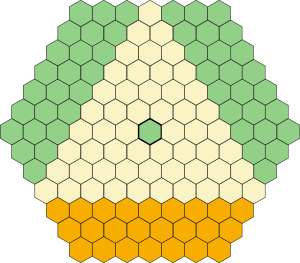 On its first move only, a king may jump to any vacant or enemy-occupied cell within its territory. There are two limitations to castling:
On its first move only, a king may jump to any vacant or enemy-occupied cell within its territory. There are two limitations to castling:
There are three promotion zones: Both of the opposing player's territories, plus the Pleasure Garden (the central cell of the board). In the case of the latter, only moves into or out of the Pleasure Garden are promotable moves: Passing through the cell does not count.
Unlike standard shogi, the sannin shogi king can promote; indeed, when an alliance is formed, the non-allied king is automatically promoted. (However, a king cannot kill by illumination when it promotes. That requires an additional turn, as promotion does not take effect until the end of the promoting move.) When using standard game pieces, promotion entails turning the king blank side up.
an ally, and each player regardless of alliance must defend against check or threat of checkmate on the next move. (That is, if Middle and Last are allies, and First places Middle in check, Middle must answer the threat, even if he knows or thinks Last will come to the rescue.)
A player loses the game upon checkmate, not upon capture of the king. (That is, if Middle and Last are allied, and First checkmates Middle, the game is over, regardless of whether Last could intercede to prevent an actual capture of the king.) When mated, all the player's pieces are removed from the board and from the game: They are not captured by the mating player. Play then shifts to the mating player, regardless of whose turn it would otherwise have been.
There are three ways to win sannin shogi:
There are no rules for various rare eventualities in sannin shogi, such as draws or revealed checkmate between allies.
Allies may attack each other to gain pieces-in-hand for drops, or to weaken each other in anticipation of the two-player end game. However, if either ally is checkmated by the third player, both lose, so these are dangerous tactics.
There are two types of coordinated attack that force an alliance:
Material loss is defined as any exchange that materially benefits the attacking player. This includes check, threatened checkmate on the next move, threats against undefended pieces (something for nothing), and threats by less valuable (weaker) pieces on defended but more valuable (stronger) pieces (uneven exchange).
Possible gain by the third player elsewhere is disregarded, even if this were to make up for the material loss caused by the coordinated attack. Likewise, the sequences of the moves are disregarded, even if they prove the loss of material is more apparent than real.
For the purposes of calculating threats of uneven exchange, promoted values are ignored; the ranging pieces rook and bishop are considered equivalent and more valuable than the step movers gold, silver, knight, and the lance, which are in turn considered equivalent and more valuable than a pawn. Finally, check can be considered the extreme case of uneven exchange, so the value scale is,
Regardless of whether the situation is a discovered or a dual attack, it does not force an alliance if any attacking move is a direct defense against a threat of material loss, as defined above. That is, if First attacks Middle, and Middle defends by moving in such a way that First now checks Last (a discovered attack), this does not force an alliance between First and Middle. Or, if Last attacks First, and First defends by checking Last, and then Middle threatens Last's rook, this does not force an alliance between First and Middle either.
describes some of the moves as "strange" considering the professional level of the players.
The players were,
The game began without an alliance.
Shogi variant
Many variants of shogi have been developed over the centuries, ranging from some of the largest chess-type games ever played to some of the smallest...
invented circa 1930 by Tanigasaki Jisuke and recently revived. It is played on a hexagonal grid of border length 7 with 127 cells. Standard shogi
Shogi
, also known as Japanese chess, is a two-player board game in the same family as Western chess, chaturanga, and Chinese Xiangqi, and is the most popular of a family of chess variants native to Japan...
pieces may be used, and the rules for capture, promotion, drops, etc. are mostly similar to standard shogi. (See that article for an explanation of these terms.) While piece movement differs somewhat from standard shogi, especially in the case of the powerful promoted king, the main difference in play is due to the rules for voluntary and mandatory alliance between two of the three players.
Board and setup
The board is thought to have originally been in the shape of an equilateral triangle bordered by three rectangles which contained the players' home territories and promotion zones. However, in terms of movement this was equivalent to a hexagon, and the modern form of sannin shogi is played on a hexagonal board, rather like the central portion of a Chinese checkersChinese checkers
Chinese checkers is a board game that can be played by two, three, four, or six people, playing individually or with partners...
board. The three players occupy non-adjacent sides of the board; the three ranks nearest to them are their territories and their opponents' promotion zones. The 'international' arena inside the three territories remains triangular.
The board is presented here with substitutions by standard shogi pieces; for the names actually used, see below.
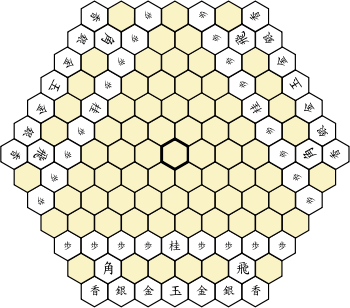 |
.svg.png) |
The central cell is called the Pleasure Garden and is an additional promotion zone, except for the king. It is drawn with a heavy or double border or otherwise made visually distinct.
In the modern game, standard shogi pieces are used. Each player wields 18 pieces, the standard shogi set of 20 less one knight and one pawn. The pieces face away from the players: That is, they point toward the gap between the opposing players' territories.
The three players represent three countries, and are called First, Middle, and Last. If two players start the game as allies, the remaining player is automatically First. Otherwise any random method may be used to determine the order of play. Play then precedes clockwise from First to Middle to Last.
Board notation

The numbered "columns" are the rows that run from top left to bottom right from the viewpoint of Middle. They are given the numbers 1 to 13 from right to left, with 7 being the central and longest column. That is, First occupies columns 1 to 3, while the territories of Middle and Last span columns 5 through 13.
The Pleasure Garden is thus cell 7g; the corners are at 1a, 1g, 7a, 7m, 13g, 13m; and at setup the three kings occupy 1d, 10m, and 10d; and the three knights 3e, 9k, and 9e.
Movement on a hexagonal board
Because each cell of a sannin shogi board is a hexagon rather than a rectangle as in other shogi variants, the pieces will necessarily move differently. Instead of four faces with adjacent squares and four corners, for eight directions total, there are six each for a total of twelve. However, except for castling and the promoted king, which is reminiscent of the queen of Western chess (indeed, it moves like the queen in Gliński's hexagonal chessGlinski's hexagonal chess
The term hexagonal chess designates a group of chess variants played on hexagonal boards. The most popular one is Gliński's hexagonal chess which was invented in 1936 by Władysław Gliński of Poland.- Gliński's hexagonal chess :...
), the pieces are fair analogues of their standard-shōgi counterparts.
Except when castling, all pieces move in straight lines. These may be step moves, where a piece moves to the nearest cell in a particular direction, or ranging moves, where a piece may continue in a particular direction as long as it does not pass through an occupied cell.
There are two kinds of paths along which pieces move:
- Passing through one of the faces of the starting cell to one of the six adjacent cells, or through this adjacent cell to continue straight in that direction. These six contiguous paths are called orthogonals in this article. They are equivalent to the four orthogonal directions on a rectangular board.
- Passing through one of the corners of the starting cell and between two adjacent cells to reach one of the six cells just beyond, or continuing in a straight line in that direction, alternatingly passing through and passing between the cells. These six skipping paths are called diagonals in this article. They are equivalent to the four diagonal directions on a rectangular board. A piece may travel along a diagonal even if the adjacent cells it passes between are occupied, since it doesn't actually pass through these adjacent cells, and this is not considered a jump, just as on a rectangular board. There are no jumping moves in sannin shogi except for the king when castling.
These twelve directions correspond to the twelve hours on a clock: The orthogonals correspond to the odd hours (the direction of the hour hand at 1, 3, 5, 7, 9, and 11 o'clock), and the diagonals correspond to the even hours (the hour hand at 12, 2, 4, 6, 8, and 10 o'clock). Only the promoted king has the power to move in all twelve.
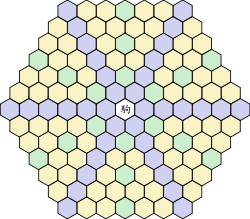 |
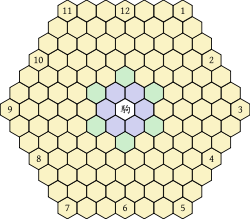 |
The pieces and their moves
Tanigasaki named the pieces after elements he considered basic to international affairs. However, they parallel the pieces of standard shogi, which are substituted for them in modern play; since the reader is likely familiar with these already, this article will use the piece names from standard shogi.
| Piece | Pron. | English | Standard equivalent | English | Prom. | Pron. | English |
|---|---|---|---|---|---|---|---|
| 輿論 | yoron | Public opinion | 玉将 | King | 旭光 | kyokkō | Sunlight |
| 軍教 | gunkyō | Military education | 飛車 | Rook | 竜化 | ryūka | Heroism |
| 外交 | gaikō | Diplomacy | 角行 | Bishop | 魔叉 | masha | Witchcraft |
| 金権 | ginken | Financial influence | 金将 | Gold general | — | ||
| 税関 | zeikan | Customs | 桂馬 | Knight | — | ||
| 殖貿 | shokubō | Trade and industry | 銀将 | Silver general | 宝 | takara | Treasure |
| 宣電 | senden | Propaganda | 香車 | Lance | 化 | ka | Change |
| 尖占 | sensen | Colonist | 歩兵 | Pawn | 弗 | doru | Dollar |

| Color coding for different types of movement | |
| The piece may step here, to the nearest cell (orthogonal or diagonal). | |
| The piece may range along these rows, crossing any number of empty cells. | |
| The promoted king may range in one of these directions, or illuminate (kill at a distance) in all. | |
The king
The king (K; "public opinion" in Tanigasaki's nomenclature) may step to any adjacent (orthogonal) cell (1, 3, 5, 7, 9, or 11 o'clock). A king may also castle on its first move, subject to certain restrictions (see below).A promoted king (+K; "rising sun") may range along any of the twelve orthogonals or diagonals.
| King | Promoted king | |
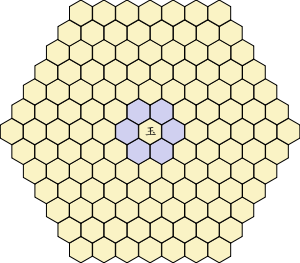 |
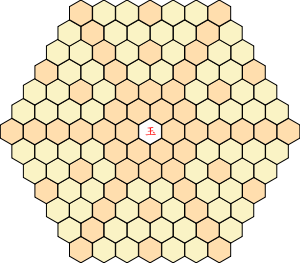 |
A promoted king also gains the power to "kill by illumination": It may capture, without moving, any pieces that it could capture if it were to move. That is, it may capture more than one piece, but only one piece in any direction and only if they are unprotected by either opposing player. (It is not clear if it must capture all such pieces, or if it may be selective.) It cannot combine this power with a physical move.
A king automatically promotes if the other two players enter into an alliance. A non-allied king (promoted or otherwise) that reaches the central cell of the board (the Pleasure Garden) wins the game.
The rook
The rook (R; "military education") may range along one of the forward or side orthogonals (9, 11, 1, or 3 o'clock), or along the diagonal directly backwards (6 o'clock).A promoted rook (+R; "heroism") has a more powerful retreat: It may range along any one of the six orthogonals.
| Rook | Promoted rook | |
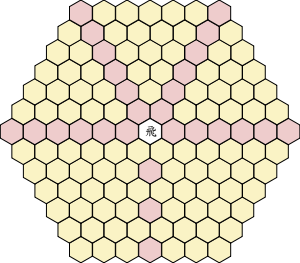 |
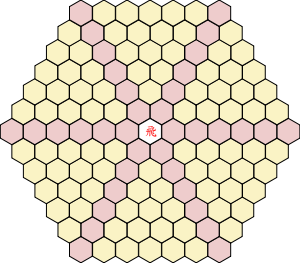 |
|
| Rooks at startup | ||
 |
The bishop
The bishop (B; "diplomacy") may range along any one of the six diagonals, and can reach only one-third of the board. (Compare Gliński's hexagonal chessGlinski's hexagonal chess
The term hexagonal chess designates a group of chess variants played on hexagonal boards. The most popular one is Gliński's hexagonal chess which was invented in 1936 by Władysław Gliński of Poland.- Gliński's hexagonal chess :...
, which has three bishops for this very reason.)
A promoted bishop (+B; "witchcraft") gains the power to step to any adjacent (orthogonal) cell. That is, it may move as a bishop or as a king, and can therefore reach every cell on the board.
| Bishop | Promoted bishop | |
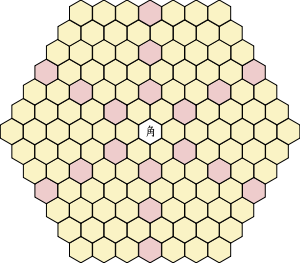 |
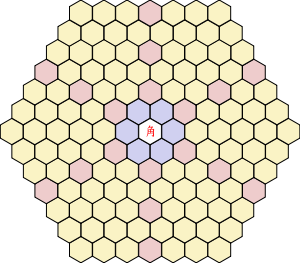 |
|
| Bishops at startup | ||
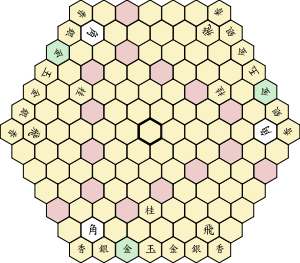 |
The gold general and the knight
The gold general, or simply 'gold' (G; "financial influence") may step to one of the orthogonal forward or side cells (9, 11, 1, or 3 o'clock), or to the diagonal cell directly forward or backward (6 or 12 o'clock).The knight (N; "customs") may step to any side cell, orthogonal (3 or 9 o'clock) or diagonal (2, 4, 8, or 10 o'clock).
Neither has the ability to promote.
| Gold | Knight | |
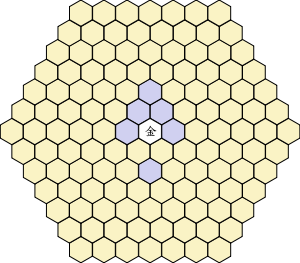 |
 |
The silver general
The silver general, or simply 'silver' (S; "trade and industry") may step to one of the orthogonal forward or rear cells (11, 1, 5, or 7 o'clock), or to one of the forward side diagonal cells (10 or 2 o'clock).A promoted silver (+S; "treasure") gains the power to range along the forward and rear diagonals (12 and 6 o'clock).
| Silver | Promoted silver | |
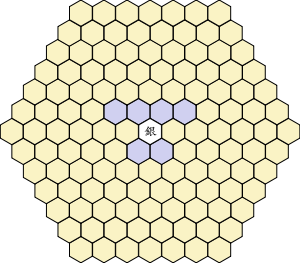 |
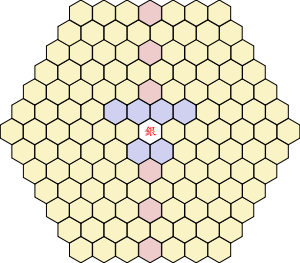 |
The lance
The lance (L; "propaganda") may range along either of the two forward orthogonals (11 or 1 o'clock). As a consequence, it may run out of room to move, and will thus be required to promote so that it can move further, although it is always advantageous to promote a lance.A promoted lance (+L; "transformation") gains the power to range along the rear orthogonals (5 and 7 o'clock) as well.
| Lance | Promoted lance | |
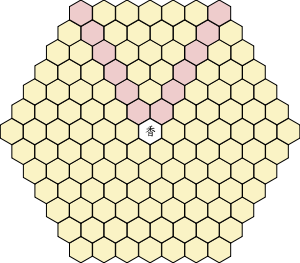 |
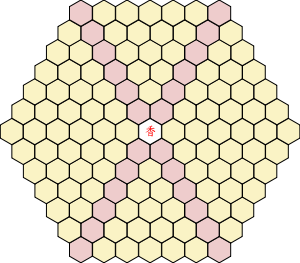 |
|
| Lances at startup | ||
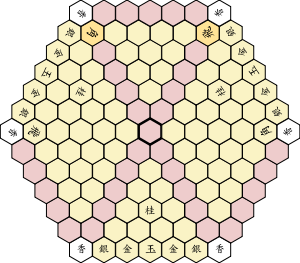 |
The pawn
The pawn (p; "colonist" or "pioneer") may step to either of the two forward orthogonal cells (11 or 1 o'clock). As a consequence, it may run out of room to move, and will thus be required to promote so that it can move further, although it is always advantageous to promote a pawn.A promoted pawn (+p; "dollar") moves like a gold general.
| Pawn | Promoted pawn | |
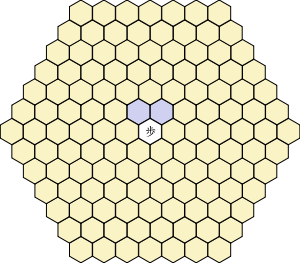 |
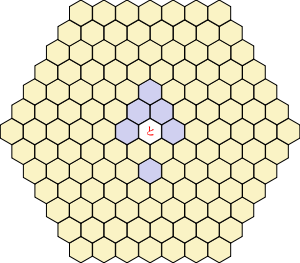 |
Capture
Capturing is done by displacement as in standard shogi. The one exception is the power of "illumination" of the promoted king.A piece may be captured regardless of any alliance the mover may have with its owner. A castling king may capture as any other moving piece does.
Drops
Captured pieces are truly captured in sannin shogi. They are retained "in hand", and can be brought back into play under the capturing player's control. On any turn, instead of moving a piece across the board, a player can take a piece he has previously captured and place it on any empty cell, facing away from himself. The piece is now part of the forces controlled by that player. This is termed dropping the piece, or just a drop.However, unlike in standard shogi
Shogi
, also known as Japanese chess, is a two-player board game in the same family as Western chess, chaturanga, and Chinese Xiangqi, and is the most popular of a family of chess variants native to Japan...
(see article for examples), there being no proper files on a hexagonal board, there is no limit on the number of pawns per file. The restriction against dropping on the far rank (row a in the case of Middle) applies only to pawns and lances, as all other pieces can move from that position.
Castling

- The king must not be, or ever have been, in check.
- Once an alliance is formed, no further kings may castle.
Promotion
Promotion rules are similar to standard shogi, except for the larger number of promotion zones and the restriction against allied players promoting.There are three promotion zones: Both of the opposing player's territories, plus the Pleasure Garden (the central cell of the board). In the case of the latter, only moves into or out of the Pleasure Garden are promotable moves: Passing through the cell does not count.
Unlike standard shogi, the sannin shogi king can promote; indeed, when an alliance is formed, the non-allied king is automatically promoted. (However, a king cannot kill by illumination when it promotes. That requires an additional turn, as promotion does not take effect until the end of the promoting move.) When using standard game pieces, promotion entails turning the king blank side up.
Checkmate and winning the game
A player may not move into check or remain in check, even check by an ally. Likewise, a player may not check or checkmateCheckmate
Checkmate is a situation in chess in which one player's king is threatened with capture and there is no way to meet that threat. Or, simply put, the king is under direct attack and cannot avoid being captured...
an ally, and each player regardless of alliance must defend against check or threat of checkmate on the next move. (That is, if Middle and Last are allies, and First places Middle in check, Middle must answer the threat, even if he knows or thinks Last will come to the rescue.)
A player loses the game upon checkmate, not upon capture of the king. (That is, if Middle and Last are allied, and First checkmates Middle, the game is over, regardless of whether Last could intercede to prevent an actual capture of the king.) When mated, all the player's pieces are removed from the board and from the game: They are not captured by the mating player. Play then shifts to the mating player, regardless of whose turn it would otherwise have been.
There are three ways to win sannin shogi:
- If each player plays independently, the player remaining after the other two have been mated is the winner.
- If there is an alliance, then the non-allied player wins by mating either opposing player, and the game ends. That is, if your partner loses, you lose. However, if the non-allied player is mated, the alliance is dissolved, and the two erstwhile allies continue the game between them.
- If any player not in an alliance (whether there is one or not) moves the king or promoted king (that is, the Public Opinion or the Sunlight) to the Pleasure Garden, that player wins and the game ends. (Note that the prohibition against moving into check holds for this move as for any other.)
Other rules
Repetition of board positions is not allowed. Unlike standard shogi, it is the player who starts the repetitive sequence who must vary the move.There are no rules for various rare eventualities in sannin shogi, such as draws or revealed checkmate between allies.
Alliances
Two players may team up against the third, forming an alliance. They may attack each other, but not place each other in check until the third player is defeated, at which point the alliance is annulled. They may not move each other's pieces.Allies may attack each other to gain pieces-in-hand for drops, or to weaken each other in anticipation of the two-player end game. However, if either ally is checkmated by the third player, both lose, so these are dangerous tactics.
Forming an alliance
An alliance may be entered voluntarily before the start of the game. However, if two players gang up on the third at any time during the game, subject to the following definitions, an alliance is automatically formed. An alliance may not be broken except by defeat of the non-allied player.There are two types of coordinated attack that force an alliance:
- Discovered attackDiscovered attackIn chess, a discovered attack is an attack revealed when one piece moves out of the way of another. Discovered attacks can be extremely powerful, as the piece moved can make a threat independently of the piece it reveals. Like many chess tactics, they succeed because the opponent is unable to meet...
: One player moves out of the way of a second so that the second threatens the third with "material loss", and - Dual attack: Two players in turn make threats of "material loss" against separate pieces of the third player, so that the third player cannot escape both threats.
Material loss is defined as any exchange that materially benefits the attacking player. This includes check, threatened checkmate on the next move, threats against undefended pieces (something for nothing), and threats by less valuable (weaker) pieces on defended but more valuable (stronger) pieces (uneven exchange).
Possible gain by the third player elsewhere is disregarded, even if this were to make up for the material loss caused by the coordinated attack. Likewise, the sequences of the moves are disregarded, even if they prove the loss of material is more apparent than real.
For the purposes of calculating threats of uneven exchange, promoted values are ignored; the ranging pieces rook and bishop are considered equivalent and more valuable than the step movers gold, silver, knight, and the lance, which are in turn considered equivalent and more valuable than a pawn. Finally, check can be considered the extreme case of uneven exchange, so the value scale is,
- K > (R = B) > (G = S = N = L) > p.
Regardless of whether the situation is a discovered or a dual attack, it does not force an alliance if any attacking move is a direct defense against a threat of material loss, as defined above. That is, if First attacks Middle, and Middle defends by moving in such a way that First now checks Last (a discovered attack), this does not force an alliance between First and Middle. Or, if Last attacks First, and First defends by checking Last, and then Middle threatens Last's rook, this does not force an alliance between First and Middle either.
Rules that change in an alliance
Several rules that change or come into force when an alliance is made have been mentioned above:- Any of the three kings which has not already castled loses the ability to do so;
- The non-allied king is immediately promoted;
- Allied players lose the ability to promote their pieces, though any pieces already promoted remain so (it is not clear if the ability to promote returns once the alliance is dissolved);
- The two allied kings lose the right to win by reaching the Pleasure Garden (it is not clear if this ability returns once the alliance is dissolved);
- Neither ally may check or checkmate the other, and
- Both allies lose if either is checkmated.
Sample game
Here are the first six rounds of a game played at a meeting of the International Shogi Research Group on 28 May 1932. John FairbairnJohn Fairbairn
John T Fairbairn, born in Newcastle upon Tyne, lives in London where he works as a political journalist, author and translator. His hobby is board games, particularly Go and Shogi. As a specialist in Oriental Languages, he has translated and written many books about these games...
describes some of the moves as "strange" considering the professional level of the players.
The players were,
- First: Kimi Kinjiro (8-dan)
- Middle: Miyamatsu Kanzaburo (7-dan)
- Last: Yamamoto Kusuro (7-dan)
The game began without an alliance.
| 1. | P3c-4d | P10k-10j | P11g-10g | |
| 2. | S-2d | S-9l | S-10e | (all three players shield their kings with silvers) |
| 3. | S-2e | P7k-6j | P8d-7d | |
| 4. | P-4e | R-7g+ | Bx12l | (Middle rook promotes in Pleasure Garden; Last bishop captures Middle bishop) |
| 5. | G-3d | Sx12l | P-9g | (Middle captures the attacking bishop) |
| 6. | P4d-5e | +R-7l | R-10g | (Last rook lines up with Middle king) |

